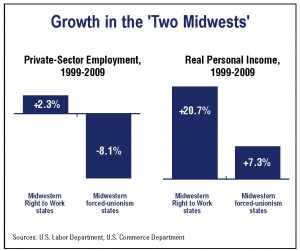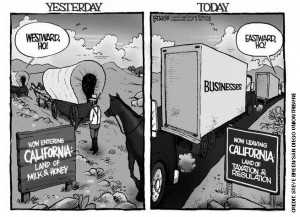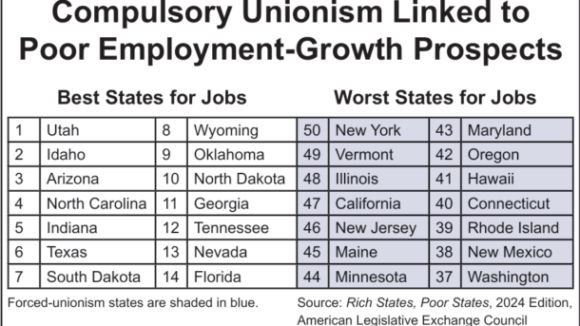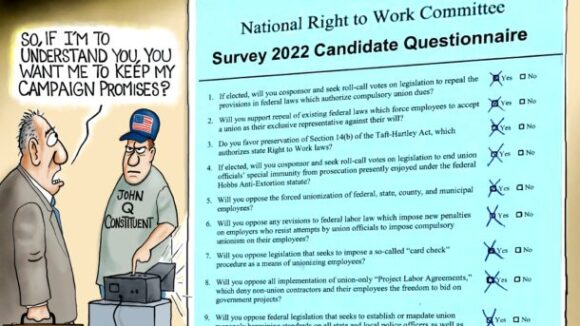Is This Any Way to Run a City’s Schools?
Leaked CTU Proposals Won’t Do Anything to Improve Schools’ Poor Performance

Legislators Look at ‘Oklahoma Model’ For Stronger Economic Growth
It’s been more than seven decades since The Grapes of Wrath, both the John Steinbeck novel and the Hollywood movie it inspired, established the desperate migration of “Okies” from the Dust Bowl to the orchards of California as an icon of the Great Depression.
Times have certainly changed.
As an October 12 USA Today feature story noted, since 1999, “the number of Californians departing the Golden State for Oklahoma has outnumbered those going the opposite direction by more than 21,000 . . . .”
The net influx of people into the Sooner State from California and many other states with sub-par or abysmal job and income growth records is, as USA Today put it, “a sign of Oklahoma’s growing economic prowess.”
To explain the state’s recent record of economic success, the USA Today feature specifically mentioned Oklahoma’s low and relatively stable housing costs, its concentration of aerospace and defense technology expertise, and its oil and natural gas reserves.
But as important as these assets are, Oklahoma had them all in the early 1990’s, when its long-term job and income growth still trailed the national average.
The real turning point for Oklahoma’s transition from an economic laggard to an economic leader was in 1992 — when the National Right to Work Committee teamed up with local grass-roots activists to map out a multi-year campaign to pass a Sooner Right to Work law.
Benefits of Right to Work Campaign Were Evident Long Before State Law Was Passed
“In the early 1990’s, the ‘Dust Bowl’ was already a distant memory, but Oklahoma’s job climate still seemed pretty dry,” commented Matthew Leen, vice president of the National Right to Work Committee.

“From 1984 through 1994, the decade before the Committee program to pass a Right to Work law in Oklahoma was initiated, private-sector employment in Oklahoma increased by less than a third as much as the national average, according to the U.S. Labor Department.
“Over that same decade, inflation-adjusted U.S. Commerce Department data show Oklahoma’s real personal income grew by just 2.3%, less than a tenth of the nationwide percentage gain.
“But in 1994, the seeds of change were planted when, thanks to the lobbying and citizen-mobilization efforts of the Right to Work movement, 12 new avowed foes of compulsory unionism were elected to the Oklahoma Legislature.
“Also in 1994, unabashedly pro-Right to Work candidates were elected as governor, lieutenant governor, and labor commissioner.
“It would take additional years of hard work, spanning the 1996, 1998, and 2000 election cycles, for grass-roots activists to get to majority support for the Right to Work in both legislative chambers.
“But the benefits of the Right to Work campaign were evident long before a state law could be passed.
“As more and more union-label legislators were replaced with Right to Work advocates during the 1990’s, the state’s political climate became more amenable to private-sector job and income creation in a host of ways.
“From 1995 to 2001, the year the Right to Work law was finally adopted, private-sector employment in Oklahoma grew by 15.2%, 14% more than the overall national increase.Sooners’ real personal income grew by 24.1%, outpacing the national average.”
Right to Work Edge Clear In Region After Region
“Unfortunately, the adoption of the 2001 Right to Work Amendment prohibiting the termination of employees for refusal to pay dues or fees to an unwanted union did not immediately break Big Labor’s grip over roughly 65,000 private-sector Sooner workers,” Mr. Leen continued.
“Until 2003, union lawyers kept the Right to Work Amendment tied up in court. But since the state Supreme Court rejected Big Labor’s anti-Right to Work lawsuit late that year, Oklahoma has had one of the strongest economies in the country.
“From 2003 through 2009, real income in Oklahoma grew by nearly twice as much as in the U.S. as a whole. The U.S.’s private-sector employment was flat over that period, but Oklahoma’s grew by 4.4%.”
The outstanding recent gains of Oklahoma are of a piece with the long-term economic performance of all 22 Right to Work states, including those whose forced-dues bans have been on the books for decades.
For example, from 1999 to 2009, the five Midwestern Right to Work states (Iowa, Kansas, Nebraska, North Dakota, and South Dakota) experienced aggregate private-sector job growth of 2.3%. Over the same period, the seven Midwestern forced-unionism states (Illinois, Indiana, Michigan, Minnesota, Missouri, Ohio, and Wisconsin) lost 8.1% of their private-sector jobs.
More and More Citizens Recognize Their States Require Fundamental Reform
It shouldn’t come as any surprise that forced-unionism states are lagging behind Right to Work states by all the most significant economic measures. Big Labor’s counterproductive work rules and fomentation of the “hate-the-boss” mentality lead to slower revenue growth in the unionized businesses themselves.
That translates into smaller compensation increases for employees and less job growth or, very frequently, job losses.
On top of that, union bosses funnel a huge portion of the forced dues and fees they collect into efforts to elect and reelect state and local, as well as federal, politicians who support more forced unionism, higher taxes, and more red-tape regulation of business.
“More and more citizens of Big Labor-controlled states like Wisconsin, Missouri, Indiana, Pennsylvania and Maine recognize that their states require fundamental reform in order to get their economies back on track,” noted Mr. Leen.
“That’s one important reason why avowed Right to Work supporters running in slow-growth states racked up a net gain of hundreds of state House and Senate seats in this year’s elections.”
“The fact is, compulsory unionism impedes private-sector job creation and income growth in every part of the business cycle. It’s clear that the national recession’s end won’t suffice to turn Wisconsin, Missouri, Indiana, Pennsylvania and Maine around.
“On the other hand, the experiences of Oklahoma and many other Right to Work states furnish strong evidence that economically troubled states could greatly accelerate their job and income growth by passing Right to Work legislation.”
‘Getting There Is Half the Fun’
Mr. Leen added: “There is a second important point illustrated by the ‘Oklahoma model’: Getting there is half the fun.
“Long before forced union dues and fees were banned in Oklahoma, the state’s economy was already benefiting greatly from the campaign to pass a state Right to Work law.
“From 1994 through 2000, the number of union lackeys in the Oklahoma Legislature diminished in each election cycle thanks in large part to the Right to Work candidate survey program.
“That means, with each election cycle, the Legislature was less apt to hinder job and income growth by approving new unreasonable taxes and regulations. And the Legislature became more apt to reform existing anti-growth policies.
“Even if Big Labor had somehow in the end managed to block enactment of Oklahoma’s Right to Work law, the benefits of ‘getting there’ would have remained.
“Unfortunately, this isn’t true when well-meaning would-be reformers skip over the process of building Right to Work legislative strength and instead try to abolish forced union dues willy‑nilly in a ballot initiative.
“Over the past half century, the track record of efforts to pass new Right to Work laws through ballot initiatives is poor. And unlike legislative lobbying campaigns, ballot initiatives do nothing to improve the quality of a state’s elected officials.
“Concerned citizens who want to transform their state into ‘another Oklahoma’ should look not just at the content of the Sooner Right to Work Amendment, but also at the eight-year process by which it became law.”

Leaked CTU Proposals Won’t Do Anything to Improve Schools’ Poor Performance

Wherever Big Labor wields the power to collect forced union dues, union bosses funnel a large share of the confiscated money into efforts to elect and reelect business-bashing politicians. Employment growth tends to lag as a consequence.

Members Insist They Keep Pro-Right to Work Campaign Promises